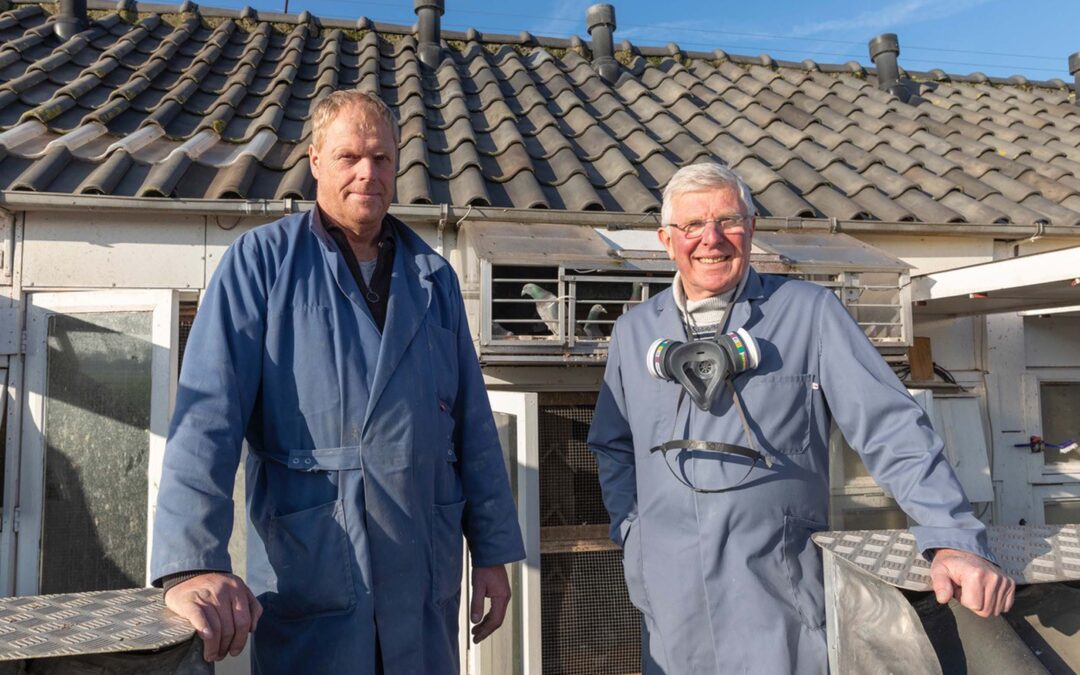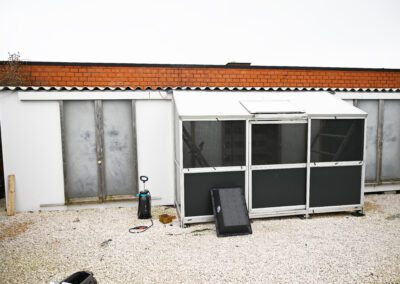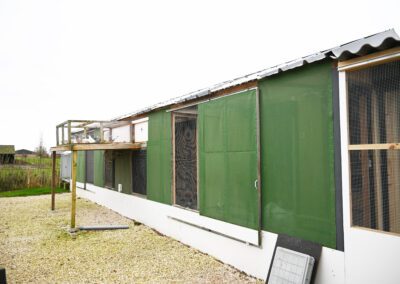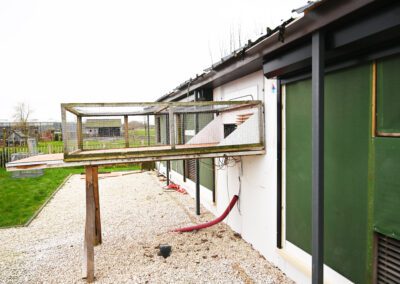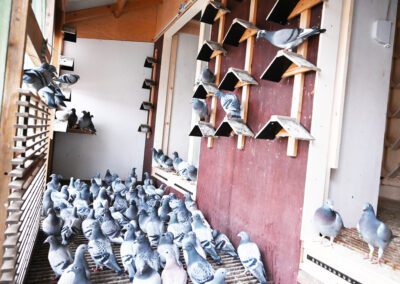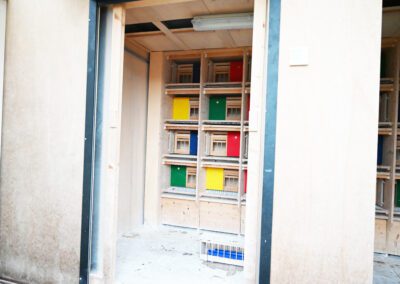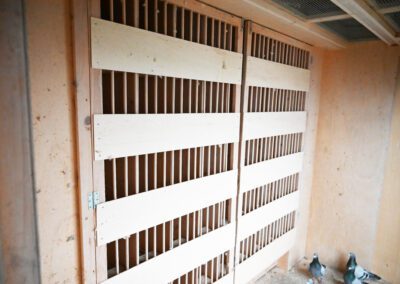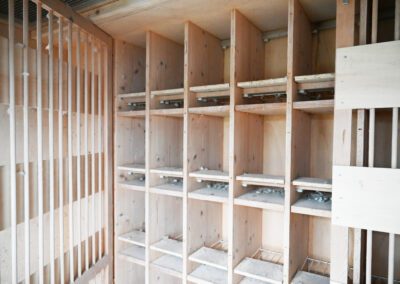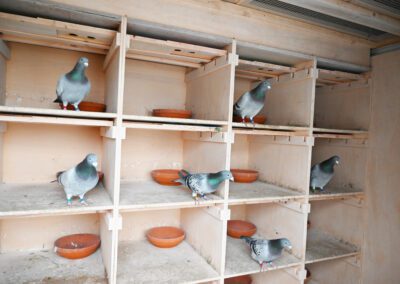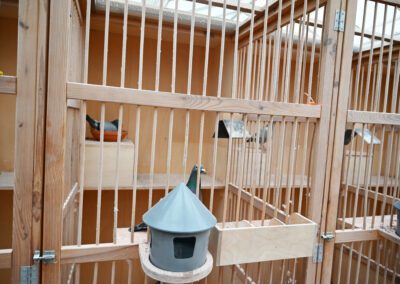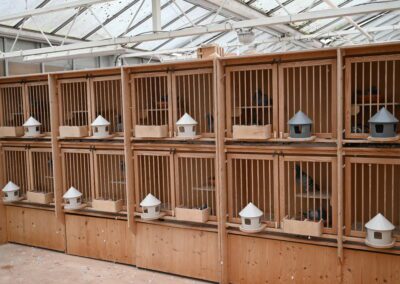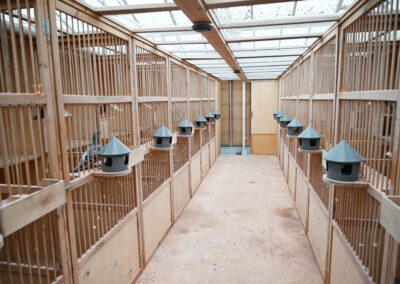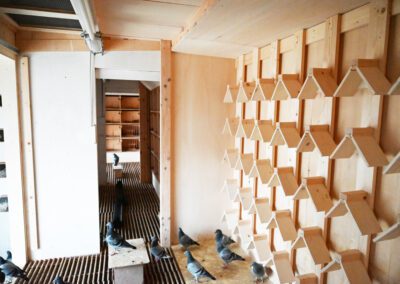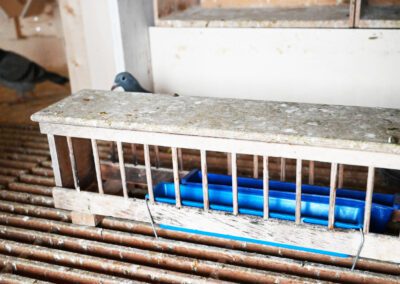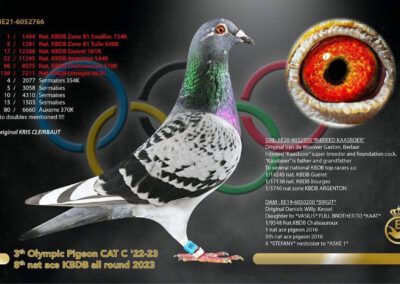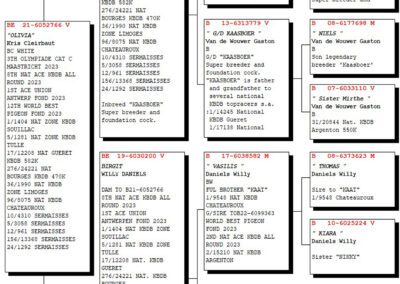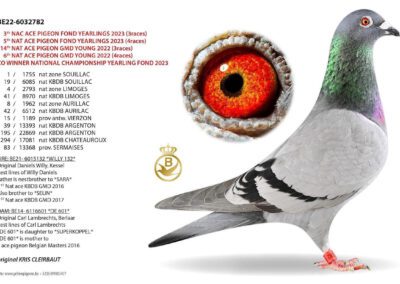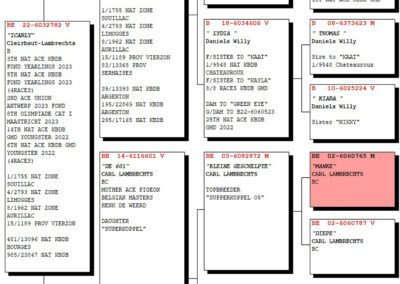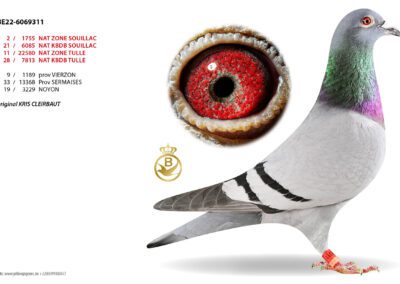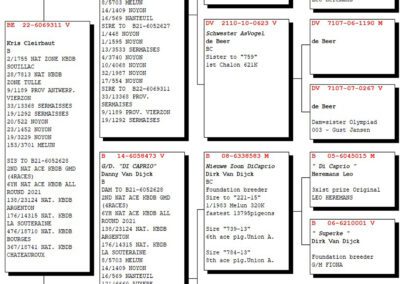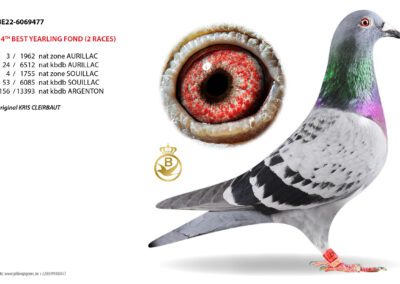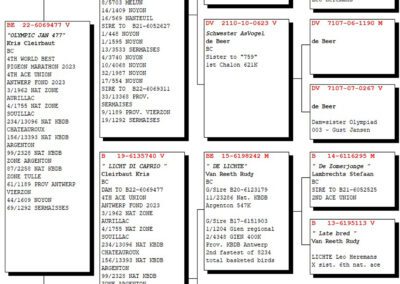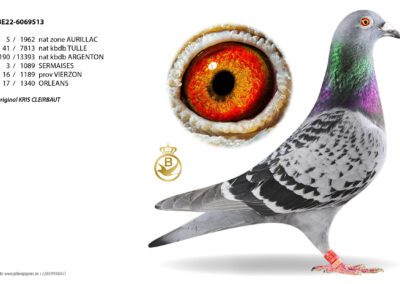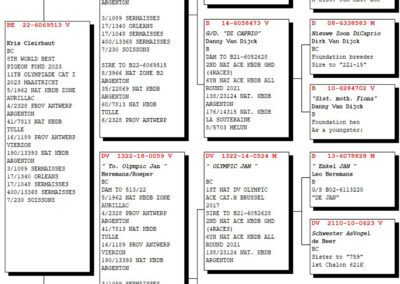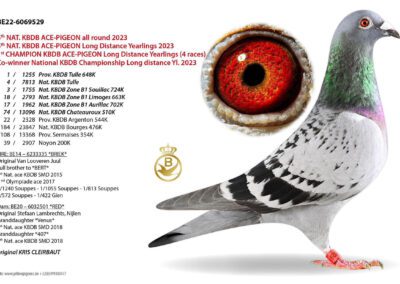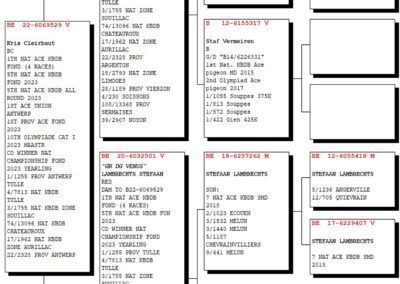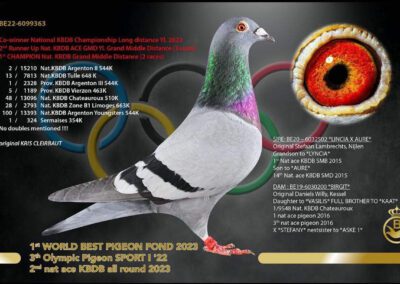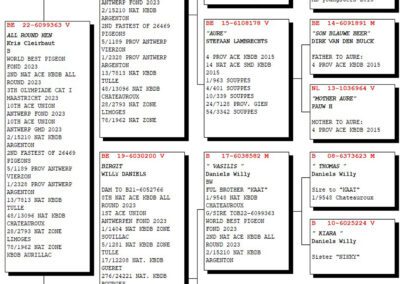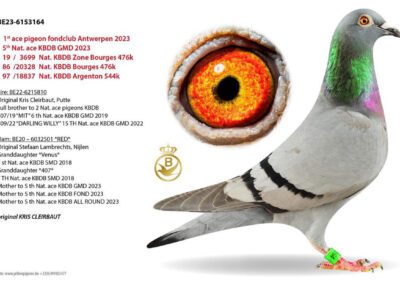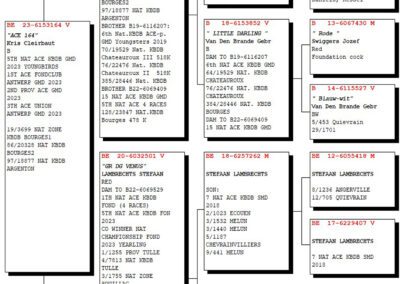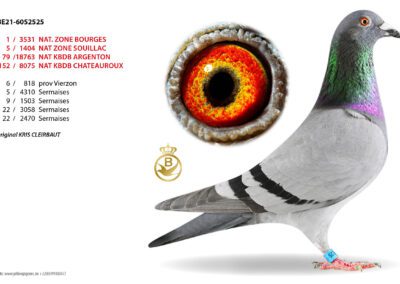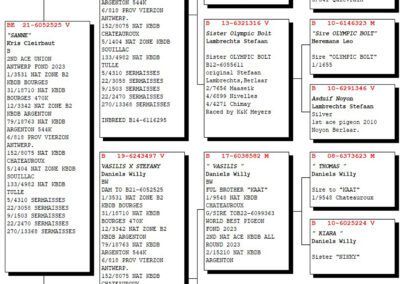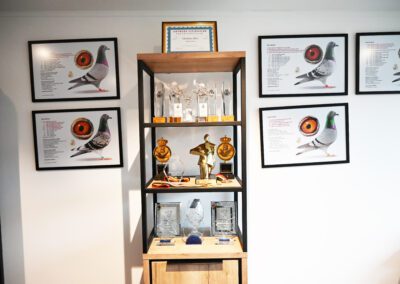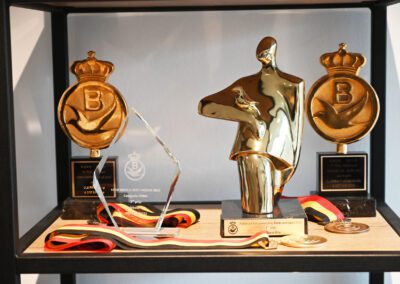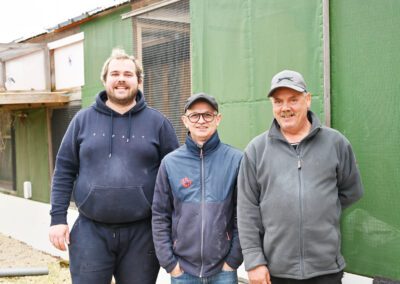Reeuwijk – “It has to be about the youngsters. The old birds didn’t fly well this year, everyone knows that, so we can skip that,” is the first thing I hear when I make contact (despite that Willem did achieve 1st Ace pigeon middle distance and 1st Ace pigeon long distance in Rayon Oost of Afd. 5 Zuid-Holland). Willem de Bruijn has always been straightforward and that has not changed until today.
There is no shortage of clarity. That is very enlightening but can also be very confrontational. If someone calls him and complains about his own performance, it doesn’t take long before he gets the following question: do your racers come from good ones? Then the conversation very often ends very quickly. This frontal approach is not always appreciated. Even when someone expresses an opinion on something, the question invariably follows whether he has tried it himself. He writes every week what is on his mind and also how he guides his colony.
Could there be anything that he has not tested extensively? Still Willem is looking to improve methods by trying them out himself, only to find out most of the time that the simplest way is often the best. And the eternal search for better pigeons also continues unabated. When you can read in detail in a weekly column what someone does and does not do and what his considerations are, you already get quite a picture of his hobby and the experience that goes with it. We will attempt to dig a little deeper.
Willem de Bruijn is past 70 and still passionately engaged in his hobby, “Fondness and not Sport. The latter is a word that does not suit our hobby,” is his opinion. Still full of fire and with the same will to win. His wife Joke, when asked how she would describe her husband, says she thinks he is quite a streamer. “He doesn’t take himself too seriously when things don’t work out once and can happily laugh at his self.” He does not contradict this characterization himself, so it must be pretty accurate.
Willem raced through ‘pigeon racing’ at hurricane speed in his career and took a lot of followers in his wake. As soon as he is awake, he is 100% on, follows everything with great interest (if someone plays well, he is the first to send a message) and forms an opinion about everything based on his own experience.
With the old pigeons, things did not work out the way Willem would have liked in 2023. He doesn’t want to use it as an excuse, but we will do that for him: concerns about the health and wellbeing of close family members and the attention this required, certainly played a role. And Jan Ouwerkerk used to say: even if there is something wrong with your little finger, the pigeons are not 100%. Everything has to be right and your head has to be empty to play well. And he waited too long to intervene, says Willem himself afterwards. In short, the old ones didn’t do well enough and that’s why we put a stop to them in this report.
Young pigeons
With the youngsters, it was a different matter. They did what they have been doing for years, flying things to pieces. For example, they won a lot of ace titles at national level and Willem had the best young pigeon in the Netherlands for the Olympiad in Maastricht.
But there is room for improvement there too. Because the last flight they failed. Because some started to moult in the little feathers and the others started to ‘think’ about it. It was enough for the last week not to be top. This is the consequence of an experiment that worked out well in 2022 but not in 2023.
The ‘Method’
It starts with good pigeons. That is the basis of everything. ‘Good and the rest is nonsense’ has become a catchphrase, but of course there is more. “The main things for me are good pigeons, a good loft that is also well ventilated and a good, fixed care system. Those are the pillars. So not using a complicated system, but of course the basics have to be in order,” according to Willem by thinking logically and distinguishing side issues from main ones. “Keeping the big picture right,” you get good pigeons by searching, trying, playing them a lot and searching and playing them again. It is difficult to say what a good loft is. The pigeons have to tell you if it marches well stay away from it altogether. If the pigeons don’t look good and feel limp, you may be rigorous. I once sawed out half the ceiling in the middle of the youngster season and replaced it with netting. It worked. In all types of weather the windows have been wide open day and night ever since. With fans running at full speed (one in each of the four compartments), it provides plenty of fresh air. It has to, because over two hundred youngsters live in two rather small compartments. Luxury is unknown to my lofts; it is completely absent. The materials used years ago when furnishing the loft are still in it. We didn’t want it to cost too much back then, but it still works fine,” says Willem.
Those lofts are not really super clean. The scraper flies smoothly over them every day and there is plenty of dust in the curtains (which serve for blackout purposes) and in the double gauze in the ceiling. It doesn’t bother the pigeons. They shine like crazy.
Early on the wings and resistance
“Youngsters go out immediately after weaning, predator or not. I ‘teach’ the early youngsters to fly as soon as possible. I do that by putting old pigeons among the youngsters. The youngsters easily follow those old pigeons into the air. In the same loft, the later rounds are weaned off and not kept apart first. Those later ones then follow the older youngsters again and always take to the wing easily. They do often even very quickly, some even as young as six weeks old. Those youngsters do drop out of the plough a bit earlier in the beginning, but they learn early on that when the flap is open they have to take to the air. That’s a whole lot better than first spending weeks in the coop and in the garden and only training leg muscles. Learned young is done old.
The prerequisite is that – even with some luck perhaps – they get through teething well. But you can do something about that yourself. At weaning, the youngsters are inoculated against paramyxo-rota. It seems that this makes adeno-coli infection milder and certainly far fewer pigeons die. I personally think that the intestines play a big role in disease or health. Keeping those intestines calm and healthy is the task. For that, I give them Roni from Comed in the water for months or Collinol plus from DHP Cultura over the feed. These create a more acidic intestinal environment. Vinegar doesn’t do that; it gets neutralized in the stomach. Roni and Collinol only take effect in the gut. Of course, they are neither medicines nor panaceas. It just creates an optimal environment in the gut and that helps to resist adeno infection – which causes coli to strike – more easily. They just get sick less quickly and less violently during a viral attack. I do notice that it has become very different in recent years from before. Earlier, the youngsters here had serious problems with the childhood diseases every year, but major problems have fortunately been absent in recent years. Maybe it is due to staying closer to nature, giving lots of oxygen, inoculating with a combination inoculant and not turning them into greenhouse plants. I wouldn’t know otherwise.”
Training youngsters
In early May, the last youngsters are about 7-8 weeks and then the training baskets are brought out. If the weather is suitable, the youngsters are taken a few kilometers away, not too far the first few times. On returning home, there is some candy seed ready. The first few times, of course, they are a bit upset and this stress has to be relieved. After three or four drop-offs, the pigeons are at 10 kilometers and at that distance I release them until they get the hang of it and fly home in a straight line from the basket. That’s why you have to start in time, because young pigeons learn quickly at a young age. It must be well instilled in them that they must immediately take the right direction without first flying in circles at the release point. That usually only happens after at least 10 times and sometimes after 20 times of training. This year it was after the 15th time.
Only then did they go straight home from the basket. Then they went to 25 kilometers, which didn’t run quite right the first time. We are talking about the end of May then!!! Then they went three times to 40 kilometers with the pigeons of two fanciers who are friends and what you see is that mine fly the first two times to the fancier at the furthest distance and then fly back to their own loft. After that they understand that and immediately drop to the fancier at the shortest distance. When they get to that point then they are ready to go with the association.
In 2023, they went with the container four times prior to the first prize flight and then they learn to go out of even bigger flocks and I can face the season with peace of mind.
In between flights, I have stopped charging myself. Because I don’t think it helps. It can even work against you because the pigeons get fed up and are fine with it if the competition is not flawless and send their cat. If I saw an advantage in it I would really do it, you can be assured of that.”
In his column, Willem regularly insists on the importance of well-prepared youngsters. “So how is it that hardly anyone does it?” he wonders almost in despair, you have to start when you can and not when you absolutely have to!!! There are only advantages in that.” While playing with the youngsters, they are separated towards the nicer flights. At basketing, they are not left together and are quietly caught. Good pigeons don’t need any more.
Supplementary lighting: to light or not to light
In 2022, Willem took the test by darkening longer (until 10 July) and not supplementary lighting in August until the end of the season, expecting that the combination of giving 18 hours of light – they believe it is high summer as a result – and the sun’s rapid lowering of its highest position towards autumn, negatively affects orientation. Especially on the last, further flights in late August, early September. The youngsters stayed in feathers without supplementary lighting and did great until the last flight. But the intention to test whether the theory of better heading was also true with southeast winds could not be tested because of any southeast wind. Just one test of whether a system is sound is not enough to draw big conclusions.
In 2023, he did the test again. But that turned out very differently than anticipated. Willem did so together with two befriended fanciers. That one summer is not like another in terms of light and also because of the extension of the playing season, the youngsters were already moulting before the end of the season. Beforehand, all three fanciers played above expectations. But they fell back one by one because the pigeons went into moulting early or were already ‘thinking about it’. Training at home was still good, but performance dropped from one week to the next. In any case, it has now become clear that playing well with youngsters until mid-September is not possible, for Willem, without lighting from August onwards. I learned something again by putting it to the test.
Paratyphoid
A subject on which there is no unanimity in pigeon country is paratyphoid fever. Vets think differently about it and give correspondingly different advice. Looking at four of the best lofts in the Netherlands, three do and one does not cure against paratyphoid. Peter Theunis does, father and son Verkerk too, Willem himself does too, but André and Bert Leideman do not. But the latter do vaccinate twice a year. Several roads lead to Rome. You see with fanciers who have had to deal with it once, that the fear is there. Then it is ‘total war’ according to Willem to get rid of that rotten disease again, cures, completely cleaning and disinfecting the lofts, inoculating, curing again, disinfecting and inoculating again, etc. Three years of being on top of it and then you get rid of it again.
He had to deal with it himself in 2011. On the after flights, after six years without problems, it was all wrong at once. And Willem will do anything to avoid having to go through that again. So whether he is not afraid of resistance by giving three-week cures every year, I wanted to know? Studies by Ghent University give a frightening picture of resistance to commonly used drugs and there is a fear that nothing will work in the long run. In response, Willem draws the parallel with trichomonas. The same noises were heard about those 10-15 years ago. And now look at it. We don’t have to give anything anymore and the pigeons have built up enough resistance to it themselves. Now of course that is a parasite and not a bacterium, but we will see.
Veterinarian Stephan Göbel says Baytril already has little to no effect against paratyphoid. Laboratory tests would show that. His colleague Fernand Mariën, Tielen (B) indicates that Baytril is the only drug that still works. You have to choose who to follow and how to act. Pigeon fanciers give many drugs anyway. Some reports list cures given which are actually a disgrace according to Willem.
Weather and releases
Willem released the Division 5 pigeons in one piece for many years. Together with Tom van Zwienen, with whom he formed a good cooperative and equal duo. Not that it always went 100% well, but very often it did, and along the way they gained a lot of experience about what can and cannot be done. It is precisely this experience that he finds so important. In his view, risk table discharges and protocols only get in the way of a well-considered decision. In his view, it is risk aversion in which no one can get hurt. Now, based on data from meteorologists who have never held a pigeon in their hands, the institute for racing guidance (IWB) gives advice that horrifies Willem. It seems like they are looking for as many problems as possible. Keep thinking for yourself is essential.
Waiting for inversions – nowadays called a warm layer at altitude – to dissolve, causing temperatures to rise considerably at release time, is the stupidest thing you can do in his eyes. The first few times with young pigeons you may take into account inversion (which is there every day except with strong winds), but after that it’s not a problem at all. With our southern neighbors, they have understood this better. On days when it is going to be towards 30 degrees, youngsters are not allowed to release if it is warmer than 19 degrees at release. And depending on the experience they have, it can’t be too far from home on such days either. Late releases at too high temperatures also cause pigeons to believe it and ‘get off’. They come home fresh in the evening or the other morning. And they will continue to do so.
In addition, fronts are very dangerous. You have to be smart about that. Unloading behind them is a guarantee of trouble. Waiting or driving through and then unloading are the only option. The way things are currently arranged with protocols and prescribed flight lines does not help to be flexible. Actually not at all, “We have much more knowledge and data than before at our disposal and yet things still regularly go wrong. It definitely doesn’t have to, as long as you think logically.”
National policy and its knock-on effect
“The direction things are going now in our fostering I find unfortunate. We listen too much to the biggest screamers and wrongly anticipate the social debate on animal welfare. The result is fewer races for the young pigeons and, if things go against us, a national program with four weekends with fewer opportunities to play the old pigeons beyond short distance etc. etc. Because of that limited program and being far too careful with release, we get a kind of pigeons that need little setback to lose courage. The toughness goes out or, if you like, the natural ability to persevere. Soon we will be left with ornamental pigeons that look like homing pigeons. I have already said enough about it in this newspaper, but we are, using among others the grandmaster competition as an example where the average reigns supreme, on a sliding scale that is not good for the future of our hobby. I could say a lot more about it but I won’t do that now and here. I do that often enough already.”
A good, fixed care system
Immediately after the last flight, the new season begins. The sifting is carried out smoothly. Willem draws a line at prizes in his own club. There, the competition is outclassed and the prizes are always earned very quickly. The remaining pigeons are given a three-week cure with Trimethoprim against paratyphoid. The breeders are separated in time to start breeding in November fully skinned. Breeders and racers are vaccinated against paramixo in time. This happens at least one month before pairing, so the youngsters get resistance from the hen. Willem thinks this is very important to bridge the period after weaning until they have built up sufficient protection through vaccinations themselves. The breeding pairs are thoroughly prepared by pre pairing, which reduces later fights and ensures that the eggs are laid at the same time.
Pairing takes place at the end of November and from the best 10-12 cocks the eggs are continually moved and put under the feeders and the racers paired in several batches. In mid-January, eggs from the best breeders are turned for the fourth time to complete the team of youngsters (about 230) around the beginning of April.
All pigeons receive the same Patagonian (racing) mixture all year round. For the breeders and pigeons with youngsters, it is available to them full time in self-filling troughs. They are also fed every morning with a morning mix consisting of grit, tovo, vegetable pellets, candy and cat pellets, and a handful for 15 pigeons. 1-2 cat pellets a day are enough to supplement the diet with amino acids not found in grains. There is then no need to use milk proteins or give other supplements, according to Willem. In addition, Multimix is given for the necessary minerals. This is the complete diet; it should be no more than that.
The youngsters are vaccinated at weaning with a Paramixo-Rota vaccine and injected with a smallpox vaccine at the end of April. To get the pigeons lice-free, Stopmite is given over the feed for 14 days (glued on with Lysocur) and later this is repeated several times a week. The other days of the week Lysocur also goes over the feed. Sunday and Monday with Roni, the other days Stopmite and/or Winmix to make it all dry again. So the youngsters get feed with a powder on top every day during the season. They get used to that easily.
The best breeder Willem de Bruijn ever had!
“Some cocks only breed good youngsters with one or two hens. But there are some who produce well with almost all hens, but those are the white ravens in pigeon racing. I myself have only once in my career had such a cock, which produces top with almost every hen in the first and second generation. And I am talking about a period of 40 years of playing with pigeons.
Such a pigeon we call prepotent and such sires are sought after by breeders of all animals.”
NL17-1279282 “MURPHY’S LAW”
1st NAT. Ace year birds De Allerbeste 2018
1st NAT. Ace short-middle distance Pipa Ranking 2018
4th NAT. Ace middle distance NPO 2018
7th NAT. Ace YB De Allerbeste 2017
9th NAT. Ace YB Pipa Ranking 2017
1 Pontoise 9,750 b.
fastest prov. 26,648 d.
3 Fontenay 11,526b.
5 Duffel 1,881b.
6 Pont St. Max 2,573b.
Father of o.a.:
* 18-473, 18th Nat. Ace YB NPO 2018 en 4e NPO Blois 15.362 d. 2019
* 19-245, 12th Nat. Ace yearbirds De Allerbeste en 1e Ace oud SS Gouwe-IJssel met 1e Meer 795b.
* 19-469, 1st Nat.Zone Tulle 1316 d. / 6th Nat. 4451 d. (at Rik Hermans)
* 20-538, 1st Peronne + fastest 40.438 d.
* 21-603, 6th Nat. Ace YB WHZB
* 23-852 “Murphy’s Honora”, 2nd Nat. Ace ½ Fond YB and 3rd Nat. Ace YB Pipa 2023
* 23-905, 20th Nat. Ace YB De Allerbeste 2023
Grandfather to o.a.:
* “Amalia”, 1 Nat. Ace YB Pipa Ranking 2022
* “Alexia”, 1 Nat. Ace YB Fondspiegel 2022
* “Best of Two Worlds”, 2nd Nat. Ace YB, 6th Nat. Ace ½ Fond YB Pipa Ranking, 4th Nat. Ace YB NPO and 1st Ace ½ Fond and old birds Gouwe-IJssel 2023
* “Ariane”, 7th Nat. Ace YB and 9th Nat. Ace YB Middle distance Pipa Ranking 2022
* “Uranus Best Boy”, 12th Nat. Ace Middle distance YB Pipa Ranking 2022
* “Olympic Pure Gold”, 1st Olympiad YB Maastricht 2024
* “It’s a Miracle”, 4th Nat. Ace YB and 9th Nat. Ace short distance YB Pipa 2023
* “Another One”, 12th Nat. Ace YB Pipa 2023 with 1st Pontoise 1585b.
* “Red Rums Janneke”, 9th Nat. Ace YB Pipa 2023
* “Olympic Isa” (Buck & Martijn de Kruijf), Olympiad old birds Maastricht 2024 en 3rd Nat. Ace old Pipa 2023
NL23-9314633 “OLYMPIC PURE GOLD”
1st Dutch Olympiad bird youngbirds Maastricht 2024
1e Lennik 4050 d.
Fastest of 8849 d.
7e Pont St. Max 20.540 d.
10e Melun 13.608 d.
16e Niergnies 4771 d.
Father : NL19-1667393 “Super James”
1e Niergnies 11.504b.
1e Pont St. Max 1487b.
2e Peronne 13.510b.
14e Peronne 5075b.
17e Pont St. Max 33.636b.
Ook vader 22-795 (20e Nat. Ace YB Pipa) and 23-658 (1st Quievrain 3995b.)
Mother: NL21-1193604 “Murphy’s Hanneke”
Co-breeding Comb. Lin
Also mother of 22-795 (20e Nat. Ace young Pipa) and 23-658 (1e Quievrain 3995b.)
Nest-sister “Murphy’s Janneke” (mother “Amalia” 1st Nat. Ace middle distance YB Pipa 2022 and “Alexia” 1st Nat. Ace YB Fondspiegel 2022)
NL23-9314672 “ONCE IN A LIFE TIME”
1e Nat. Asduif jong NPO 2023
1e Nat. Asduif jong Pipa 2023
1e Nat. Asduif jong De Allerbeste 2023<B>
3e Bierges 16.473 d.
3e snelste 32.892 d.
8e Melun 13.608 d.
13e Niergnies 4100 d.
22e Lennik 4050 d.
81e Pontoise 15.429 d.
54e Quievrain 3995 d.
60e Sens 4204 d.
V : NL14-1068219 “Froome x Schanulleke”
Vader van o.a. 19-247 (3e Nat. Asduif jong WHZB 2019 met 1e Lennik 3923 d.) en 19-327 (16e Nat. Asduif jong allround WHZB)
Grootvader van o.a. 22-899 “Best of two Worlds” (2e Nat. Asduif jong Pipa)
M : NL20-1495218 “Hunters 218”
9e Asduif jong Samenspel Gouwe-IJssel
1e Pont St. Max 3296 d.
NL23-9314852 “MURPHY’S HONORA”
2e Nat. Asduif midfond jong Pipa
3e Nat. Asduif allround Pipa
3e Nat. Asduif jong De Allerbeste
9e Niergnies 4100 d.
16e Pont St. Max 20.540 d.
54e Melun 13.608 d.
67e Pontoise 15.429 d.
69e Niergnies 21.068 d.
V : NL17-1279282 “Murphy’s Law”
1e Nat. Asduif vitesse-midfond Pipa 2018
1e Nat. Asduif jaarlingen De Allerbeste 2018
7e Nat. Asduif jong De Allerbeste 2017
9e Nat. Asduif jong Pipa 2017
1e Pontoise 9750 d. + snelste prov. 26.648 d.
M : NL19-1667626 “Honora”
4e Nat. Asduif jong midfond WHZB
5e Nat. Asduif jong midfond NPO
Mother 21-605 (1e asduif jong Gouwe-IJssel en 19e Nat. Asduif jong WHZB), 23-860 (4e Nat. Asduif jong Pipa 2023) en 23-725 (39e Nat. Asduif jong NPO)
Zus “Miss Blois”, 1e Nat. S2 Blois 11.576 d.
Results and championships 2023
National Championships young birds:
1st Olympiad pigeon youngsters Maastricht 2024 (NL23-9314633)
1st Nat. ace youngster World Best Pigeon (NL23-9314633)
1st Nat. ace young pigeon All-round NPO (NL23-9314672)
1st Nat. ace youngster Pipa-Ranking (NL23-9314672)
1st Nat. ace pigeon young birds Allround De Allerbeste (NL23-9314672)
2nd Nat. ace youngsters Middle Distance Pipa-Ranking (NL23-9314852)
3rd Nat. ace youngster Allround Pipa-Ranking (NL23-9314852)
3rd Nat. ace pigeon Allround De Allerbeste (NL23-9314852)
4th Nat. Ace Pigeon Allround Pipa-Ranking (NL23-9314680)
9th Nat. ace bird short distance Pipa-Ranking (NL23-9314680)
9th Nat. ace youngster Allround (NL23-9314847)
8th Nat. ace young pigeon Allround (NL23-9314868)
12th Nat. ace youngsters Allround (NL23-9314723)
All results of the youngbirds:
02-07 Duffel (107 km) Training
1.347 d.: 1, 2, 3, 4, 5, 6, 7, 8, 9, 10, 11, 12, 13 (99/150)
15-07 Lennik (144 km)
4.050 d.: 1, 2, 3, 4, 5, 6, 7, 8, 9, 11, 12, 13, 14, 16, 17, 19, 20, 21, 22, 23, 24, 25, 27, 29, 32, 33 (149/190)
tevens de 9 snelste duiven van de hele lossing met 8.884 d.
22-07 Quievrain (196 km)
3.995 d.: 1, 2, 3, 4, 5, 6, 7, 8, 9, 10, 11, 12, 13, 14, 16, 18, 25, 36, 43, 45, 49, 50, 51, 52, 54, 56, 58 (146/187)
29-07 Niergnies (236 km)
4.100 d.: 1, 2, 3, 4, 9, 12, 13, 14, 16, 19, 24, 25, 26, 27, 28, 29, 30, 31, 32, 33, 34, 35, 36, 37, 38, 39 (117/186)
04-08 Niergnies (236 km)
2.096 d. : 1, 2, 3, 4, 5, 6, 7, 19, 22, 24, 25, 26, 27, 28, 29, 30, 32, 38, 39, 40, 44, 45, 46, 49, 50 (121/184)
3.748 d.: 4, 6, 7, 8, 10, 11, 12, 26, 29, 31, 32, 33, 34, 35, 36, 37, 39, 50, 51, 52, 62, 63, 64, 69, 70, 71, 72, 73, 74, 75 (128/184)
Afdeling 5: 21.068 d.: 5, 7, 8, 10, 12, 13, 14, …
12-08 Pont St. Max. (341 km)
3.655 d. : 4, 5, 6, 9, 11, 20, 21, 27, 28, 29, 30, 31, 32, 38, 44, 45, 47, 50, 57, 67, 68, 79, 87 (99/182)
Afdeling 5: 20.540 d.: 6, 7, 8, 11, 16…
19-08 Bierges (146 km)
2.891 d.: 1, 2, 11, 12, 22, 24, 26, 27, 29, 45, 65, 71, 78, 88, 89, 92, 94, 97, 98 (106/174)
Afdeling 5: 16.473 d.: 2, 3, 15, 16, …
27-08 Pontoise (Cormeille)
1.585 d.: 1, 12, 24, 25, 29, 32, 39, 40 (95/171)
2.694 d.: 2, 13, 27, 28, 34, 37, 47, 48, 59, 62, 64, 65, 66, 67, 77, 89, 91, 97 (108/171)
Afdeling 5: 15.429 d.: 13, 29, 67, 68, 78…
02-09 Melun Andrezel ( 406 km)
2.312 d.: 4, 5, 6, 7, 9, 18, 20, 21, 26, 27, 28, 32, 33, 42, 46, 47, 59, 63, 81, 84, 86 (78/162)
Afdeling 5: 13.608 d.: 8, 9, 10, 11, 15, 46, 54, 55…
09-09 Niergnies (236 km)
1.972 d.: 3, 4, 9, 12, 13, 14, 15, 16, 19, 20, 21, 33, 39, 57, 60, 616, 63, 69, 70, 71, 72, 73, 78, 79, 80 (91/158)
Afdeling 5: 10.438 d.: 67, 72, 85, 90, 91, 92, 93, 94, …
16-09 Sens (440 km)
1.334 d.: 18, 20, 22, 31, 36, 37, 46, 54, 55, 63, 70, 81, 82, 83, 91, 92, 93, 94 (59/149)
Afdeling 5: 8.863 d.: 38, 43, 52, 78, 89, 95…
In conclusion
“The image of our hobby is one of old males and the occasional old female. At the same time, that implies little innovation. Still, I think you have to keep trying out whether things can be done differently and even better. And that is what happens, of course. In this way, our hobby keeps developing anyway. That also makes it fun and interesting. Despite new methods, other types of feed and by-products but also vaccines against new threats in the form of viruses, I like to repeat the most important thing I started with: it’s all about the good ones and they are rarer than we think and often read!”
For writing this article we want to thank magazine “De Duif”
